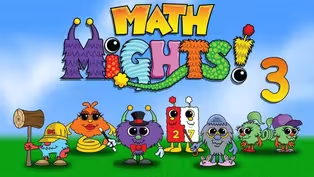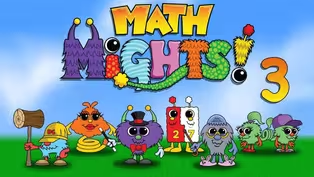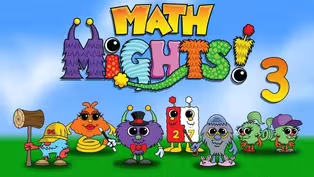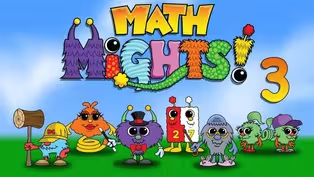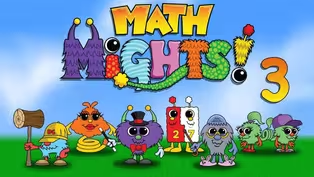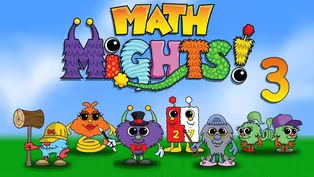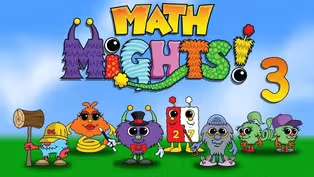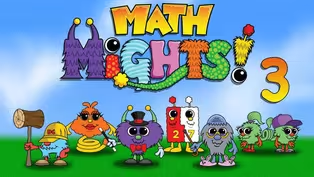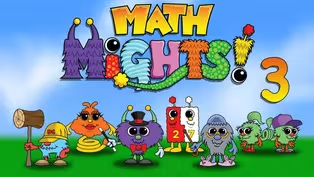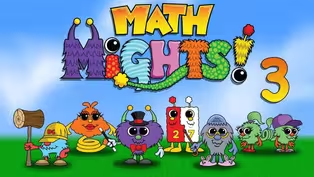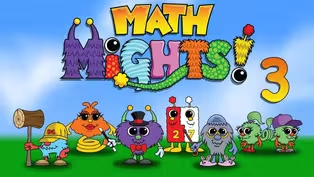Math Mights
Relating Division to Multiplication
Season 2 Episode 215 | 16mVideo has Closed Captions
Join Ms. Askew for a subtraction number talk with Springling!
Join Ms. Askew for a subtraction number talk with Springling! Get ready to have some fun with relating division to multiplication.
Problems playing video? | Closed Captioning Feedback
Problems playing video? | Closed Captioning Feedback
Math Mights is a local public television program presented by Detroit PBS
Math Mights
Relating Division to Multiplication
Season 2 Episode 215 | 16mVideo has Closed Captions
Join Ms. Askew for a subtraction number talk with Springling! Get ready to have some fun with relating division to multiplication.
Problems playing video? | Closed Captioning Feedback
How to Watch Math Mights
Math Mights is available to stream on pbs.org and the free PBS App, available on iPhone, Apple TV, Android TV, Android smartphones, Amazon Fire TV, Amazon Fire Tablet, Roku, Samsung Smart TV, and Vizio.
Providing Support for PBS.org
Learn Moreabout PBS online sponsorshipMore from This Collection
Video has Closed Captions
Join Ms. Askew for a tricky multi-step word problem with Professor Barble! (15m 59s)
Build Fraction from Unit Fractions
Video has Closed Captions
Join Ms. Askew for another multi-step word problem with Professor Barble! (15m 59s)
Video has Closed Captions
Join Ms. Askew for a division word problem with her friend Professor Barble. (15m 59s)
Video has Closed Captions
Join Ms. Askew for a division word problem with her friend Professor Barble. (16m)
Video has Closed Captions
Join Ms. Askew and Professor Barble to do a visual model with a word problem. (15m 59s)
Dividing with even larger numbers
Video has Closed Captions
Join Ms. Askew and Professor Barble to do a visual model with multiplication. (15m 59s)
Video has Closed Captions
Join Ms. Askew and Professor Barble to see if you can match visual models to word problems (15m 59s)
Dividing with Larger Quotients
Video has Closed Captions
Join Ms. Askew and Professor Barble to see if you can match visual models to word problems (15m 59s)
Video has Closed Captions
Learn about multiplying one-digit whole numbers by multiples of 10. (15m 59s)
Video has Closed Captions
Learn about multiplying numbers larger than 20. (16m)
Video has Closed Captions
Join Mrs. Askew for a Number Talk with 2 Math Might Friends! (16m)
Multiply Teen Numbers with Larger Groups
Video has Closed Captions
Join Mrs. Askew for a Number talk with 2 Math Might Friends! (15m 59s)
Providing Support for PBS.org
Learn Moreabout PBS online sponsorship(playful music) (sign whooshes) (dramatic playful music) (spring boinging) (door creaking) (Dotson squeaking) - [Children] Math Mights!
- Welcome back, third grade Math Might friends.
I'm Ms. Askew.
Are you ready to have some more fun with math today?
I sure am.
Let's check out our plan for today.
First, we're gonna do a number talk with our friend Springling, and then we're gonna move on to relating division to multiplication.
First, we're gonna warm up our brains with a number talk.
Remember, a number talk is when you take a problem and you find different ways to solve that problem.
Some you may agree with, some you may disagree with, but that's okay.
There's more than one way to solve a problem.
Let's see who's gonna join us today to help us solve our math problem.
It looks like it's gonna be our friend Springling!
Springling is a Math Might friend who was born in the city of Mathville.
She has fancy eyelashes, fluffy fur, but most importantly, she has a coily tail.
She likes to use that coily tail to hop forward and backwards on an open number line.
She likes to hop using friendly numbers in chunks.
She likes to count by 10, 20, 30.
She doesn't like to count one by one, because then she can't use her coily tail, which she absolutely loves to use.
If you look at Springling, she has a secret.
That secret is, she likes to carry plus balloons, because she likes to count and keep track of the number of hops she takes on the open number line.
Hey, Springling!
If we look at the problem that she has for us today, 91 minus 46, that looked like a really big number, but we're gonna use Springling's strategy and we're gonna try to find out the answer.
I wonder how we're gonna solve that problem.
Remember, Springling likes to take big hops.
Let's see how our friend Kavon decided to solve that problem.
Kavon started at 46 and hopped to 50.
Let's take a closer look to see how he solved it.
I already have my number line set.
We're gonna start at 46 and we want to end at 91.
Kavon started at 46 and he wanted to get to 50.
How far is it from 46 to 50?
Let's find out.
Hop, Springling, hop!
It's four.
Now that we are at 50, Kavon wants to get to 90.
How far is it from 50 to 90?
Let's find out.
Kavon takes one giant hop to 90.
That's 40.
Now that he is at 90, he wants to get to 91.
How far is it from 90 to 91?
Hop, Springling hop, it's one.
Now we're gonna find out, how far is 46 from 91?
We're gonna add 4 plus 40 plus 1.
That equals 45.
91 subtract 46 equals 45.
Now we're gonna find out how Kate decided to solve the problem.
If you look at Kate's number line, she started at 46 just like Kavon did, but it looks like Kate took smaller hops on the number line.
She went from 46 to 56.
Let's take a closer look.
I have my number line set up here.
We're gonna start at 46, and just like Kavon, we wanna end at 91.
We're gonna start at 46 and we wanna go to 56.
How far is it from 46 to 56?
Hop, Springling, hop, it's 10.
Now that we are at 56, we wanna hop to 66.
How far is that?
Hop, Springling, hop.
It's 10.
Now that we're at 66, we wanna hop to 76.
Let's find out how far that is.
Hop, Springling, hop.
It's 10.
We're at 76 and we wanna hop to 86.
How far is it from 76 to 86?
That's another hop of 10!
Now that we're at 86, we wanna hop to 90.
How far is it from 86 to 90?
We're gonna hop and it's four.
Now that we're at 90, we wanna hop to 91.
How far is it?
One hop.
If we look at Kate's number line, she took smaller hops, and that's okay.
Sometimes it's easier to count in smaller numbers or using decades of 10, but you still arrive at the same answer.
Let's add them together.
10 plus 10 plus 10 plus 10 plus 4 plus 1 equals 45.
91 subtract 46 equals 45.
Wasn't it neat to see two different ways to solve the same problem?
Kavon took large hops when he solved his problem.
And Kate took smaller hops, and that's okay.
We can solve problems in different ways.
How did you decide to solve the problem?
Now let's look at our I can statement for the day.
I can find the answer to a division problem by thinking of the missing factor in a multiplication problem.
I can figure out 32 divided by 8, because I know that 8 times 4 equals 32.
Let's look at these two problems.
What do you notice?
What do you wonder?
When I look at those two problems, I notice a multiplication and a division problem.
I wonder how those two problems are related.
Let's see what Kavon and Kate notice.
Kavon notices that both equations have the same numbers and total.
Kate notices the 12 is being broken into 3 groups, or groups of 3.
Kavon wonders, what is the missing number?
Is it the same in both equations?
Kate wonders, why is the missing number in different places?
Let's take a look at this picture.
We see the number sentence 3 groups of something equals 12.
Well, I see the 12 friends and I see the 3 groups.
3 groups of 4 friends equals 12!
Now let's compare this picture to our multiplication problem.
We still have our 12 friends, and they've been divided into 3 groups.
In those 3 groups, we see 4 friends.
So 12 divided by 3 equals 4, just like 3 groups of 4 equals 12.
Now let's look at this story problem.
Kiran had 14 melons that he shared equally in 2 boxes.
How many melons are in each box?
How can we represent this problem?
Let's take a look and see how Lin and Mia thought about it.
Lin thinks that it should be represented by showing 2 groups of something equals 14.
Mia thinks it should be 14 divided by 2 equals something.
Who do you agree with?
Let's see what Kavon thought about the story problem.
He thinks that Lin is correct because you know the total, and you know how many groups there are, but you don't know how many are in each group.
So one of the factors should be missing.
2 times something equals 14.
Kate agrees with Mia because Mia knows that if you have 14 and you divide it into 2 groups, you're going to find the number that's in each group.
Who do you agree with?
Do you agree with Kate or do you agree with Kavon?
Daniel thinks this is hilarious because he believes both can represent this situation.
Now we saw that Daniel was laughing because he thinks both can represent the situation.
Let's go ahead and prove it.
Let's look at the story problem.
Kiran had 14 melons that he shared equally in 2 boxes.
How many melons are in each box?
Let's act it out with our whiteboard.
First we're gonna start with our total or our dividend, which is 14, and then we're gonna divide it into 2 groups.
Let's draw our 2 groups.
Now we're gonna divide our total.
1, 2, 3, 4, 5, 6, 7, 8, 9, 10, 11, 12, 13, and 14.
Our total has been divided into 2 groups, 2 equal groups.
How many are in each group?
1, 2, 3, 4, 5, 6, 7, 1, 2, 3, 4, 5, 6, 7.
So 14 divided by 2 equals 7.
Now we're gonna relate it to multiplication.
2 groups of something equals 14.
We have our 2 groups.
Now we have to figure out how many will go into each group.
Let's figure that out.
1, 2, 3, 4, 5, 6, 7, 8, 9, 10, 11, 12, 13, 14.
Let's count and see how many we have in each group.
1, 2, 3, 4, 5, 6, 7, 1, 2, 3, 4, 5, 6, 7.
So 2 groups of 7 equals 14.
Now we can see how multiplication and division are related!
Wasn't it interesting how Daniel was able to solve that problem by relating it to multiplication and division?
Let's see if we can try another problem by acting it out!
3 flowers have a total of 18 petals.
Each flower has the same number of petals.
Now we're gonna draw it and act it out on our whiteboard.
First we're gonna start with our 3 circles.
The 3 circles are going to represent our 3 flowers.
Now we have our 18 discs.
These represent the petals on the flower.
We're gonna take these 18 petals and divide them equally into the 3 groups.
1, 2, 3, 4, 5, 6, 7, 8, 9 10, 11, 12, 13, 14, 15, 16, 17, 18.
Let's count and see how many petals there are on each flower.
1, 2, 3, 4, 5, 6, 1, 2, 3, 4, 5, 6, 1, 2, 3, 4, 5, 6.
So 18 divided by 3 equals 6!
Now we're gonna take that same problem and we're gonna relate it to a multiplication sentence.
What would be the related multiplication sentence for that problem?
3 groups of something equals 18.
Let's act it out.
3 flowers have a total of 18 petals, and each flower has the same number of petals.
Let's draw our 3 flowers, and we wanna make sure that there are the same number of petals on each flower.
1, 2, 3, 4, 5, 6, 7, 8, 9, 10, 11, 12, 13, 14, 15, 16, whoops, 17, 18.
How many petals are on each flower?
1, 2, 3, 4, 5, 6, 1, 2, 3, 4, 5, 6, 1, 2, 3, 4, 5, 6.
3 groups of 6 equals 18.
Now we can see how those two problems are related!
Let's make sure we understand the relationship between multiplication and division by doing one last problem.
Let's look at the problem 44 divided by 4.
How is that related to the multiplication sentence 4 groups of something equals 44?
Let's act it out on our whiteboard with our place value discs.
Let's count them up to see how much we have.
10, 20, 30, 40, 41, 42, 43, 44, that's our total.
In a division sentence, that means the dividend.
We're gonna take our dividend, or the total, and divide it equally into these four groups.
Let's do that now!
Now I can see how all 44 discs have been divided equally among our 4 groups.
Let's write that out as a division sentence.
We're gonna take our total or our dividend, which is 44.
And we divided it into 4 equal groups, and in those equal groups, we have 11.
So 44 divided by 4 equals 11.
How can we relate this division problem to a multiplication fact?
Let's see, if we have 4 groups with 11 in each group, how could we write that?
4 groups of 11.
If we look at our place value discs, that equals a total of 44.
4 groups of 11 equals 44.
And that's how multiplication is related to division!
Now it's your turn to make the connection with multiplication and division.
Thanks so much, Math Might friends, for joining us today.
I hope to see you tomorrow when we learn more about multiplication and division.
(playful music) (upbeat music) - [Announcer] Sis4teachers.org.
(screen whooshes) - [Announcer] Changing the way you think about math.
- [Presenter] This program is made possible with funding from the Michigan Department of Education, Governor's Education Emergency Funds, the state of Michigan, and by viewers like you.
(cheerful music)


- Home and How To

Hit the road in a classic car for a tour through Great Britain with two antiques experts.










Careers that Work

Support for PBS provided by:
Math Mights is a local public television program presented by Detroit PBS
